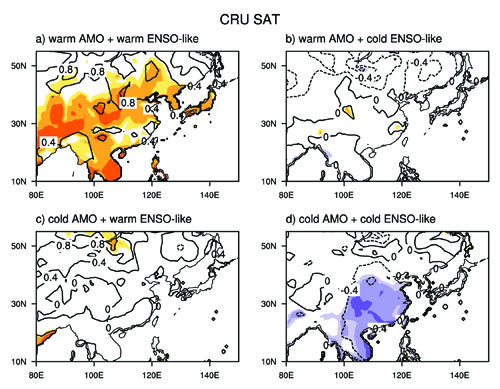Previous studies have indicated that the Atlantic Ocean acts as a pacemaker for the Pacific sea surface temperature (SST) mean state and variability. The Atlantic Multidecadal Oscillation (AMO) could modulate the variability of the El Niño-Southern Oscillation (ENSO) and Pacific Decadal Oscillation (PDO) through changing the Walker circulation, wave trains, storm track and surface winds. Both the ENSO and PDO are closely related to the East Asian winter monsoon (EAWM). Thus it is reasonable to speculate that the AMO may modulate the Pacific SST-EAWM relationship, but exactly how remains unclear.
Based on the observations and models’ simulation, Drs. HAO Xin and HE Shengping (from Nansen-Zhu International Research Centre, Institute of Atmospheric Physics, Chinese Academy of Sciences) found that the out-of-phase relationship between the variations in ENSO-like mode and the EAWM was significantly intensified when the AMO and ENSO-like SST anomalies are in phase (Figure 1).

Figure 1. Conditional composite maps of winter SAT for (a) warm AMO + warm ENSO-like SSTA, (b) warm AMO + cold ENSO-like SSTA, (c) cold AMO + warm ENSO-like SSTA, and (d) cold AMO + cold ENSO-like SSTA, using the CRU TS3.2 dataset. Light, medium, and dark shading indicate the 90%, 95%, and 99% confidence levels, respectively. (Hao and He, 2017)
“We found that the winter climate over East Asia was statistically significant warmer than normal when the ENSO-like mode and AMO were positively in phase. In such cases, the Siberian high was generally significantly weakened and anomalous anticyclones emerged over the western North Pacific.” Said Dr. HAO, “The reverse patterns occurred when the ENSO-like mode and AMO both were in negative phase. In contrast, when the ENSO-like and AMO were out of phase, the anomalies related to the EAWM tended to exhibit relatively weaker features.” Their results suggested that the phase of AMO should be taken into account in the prediction of the EAWM-related climate based on the ENSO variability.
The study was published in Journal of Climate.
Reference: Xin Hao and Shengping He (2017), Combined Effect of ENSO-Like and Atlantic Multidecadal Oscillation SSTAs on the Interannual Variability of the East Asian Winter Monsoon, Journal of Climate, DOI: http://dx.doi.org/10.1175/JCLI-D-16-0118.1.
http://journals.ametsoc.org/doi/pdf/10.1175/JCLI-D-16-0118.1
Contact: HE Shengping, hshp@mail.iap.ac.cn
